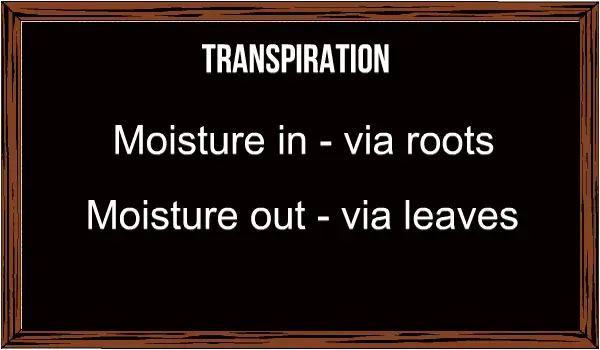Transpiration and tomato plants – Tomato Plants Perspire!
As water vapour is lost from the leaves, water is replaced through the roots.

Without this loss and replacement process, plants wouldn’t be able to absorb the nutrients they need, that are dissolved in water, and taken up through their roots.
If a plant loses moisture from its leaves faster than it can absorb moisture through its roots, the plant wilts.
If a plant absorbs moisture from its roots faster than the leaves can perspire (transpire), fruit will crack and sometimes leaves will appear bubbly/spongy as the pressure inside increases. This often happens when soil that has been allowed to become dry gets a good watering or a heavy downpour of rain!
Moisture loss and availability
If I were a tomato plant, I would probably spend a lot of my time worrying about the amount of moisture loss from my leaves and the amount of moisture available around my roots!
Keeping the right amount of moisture, or pressure, in a tomato plant is a full-time job. Get it wrong and the plant wilts or the fruit cracks or it doesn’t get enough food and that’s just for starters!
So why do we need to know this stuff … is it important for my plants?
Putting into practice
Understanding how transpiration works helps us to get the most from the circumstances in which a plant is growing. Or even change those circumstances!
Here are four conditions that effect the amount a plant transpires.
Transpiration increases as:
- Light increases
- Air flow increases
- Temperature goes up
- Air becomes more dry (less humid)
Have you noticed that when you put young plants outside for the first few times in the spring, they are more likely to wilt in the cooler conditions on the patio, than in the warmer temperatures on the windowsill!
The reason is because there is more air movement outside in the garden, so water loss increases from leaves. They may also suffer stress from the change of conditions.
One of the problems is, when plants are still young, they don’t have the root area to absorb moisture quickly enough so they may wilt in direct sunlight.
Transpiration and mineral take up
Reducing the strength of nutrient levels helps too.
Over-feeding plants on a sunny day may also cause them to wilt because higher levels of minerals in the root area, reduces the rate of water a plant can absorb because of osmosis.
Of course the more leaves a plant has, the more water it will lose when the sun comes out and the breeze blows. A good reason for de-leafing and removing lower leaves when required.
Temperature and humidity play their part too
As you might imagine, plants lose more moisture in warmer conditions. Dry air will also increase vapour loss from leaves than when it’s humid and the air is already full of moisture.
Keep greenhouse and tunnels well aerated
A greenhouse that isn’t well aerated and contains a lot of condensation will reduce transpiration greatly and growth will be reduced.
Also, foliar spraying in humid conditions is much less effective and is likely to increase the chance of disease too.
Understanding transpiration helps us to grow plants better.
See also: Leaf stomata and tomato plants

